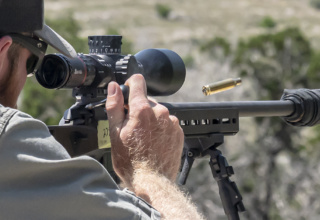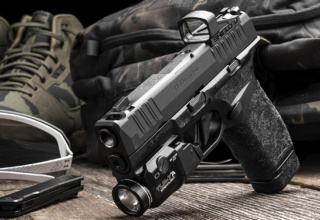Wyoming’s high, open country and infamous wind challenges this 6mm Creedmoor setup on SOTG’s High Elevation Precision Rifle Course
by Paul G. Markel
As with many modern cartridges, the 6mm Creedmoor began life as an idea to make a “wildcat” (non-standard) rifle round. The story goes that in 2007, gun writer John Snow had the idea to neck down the 6.5mm Creedmoor and use a bullet with a crazy high BC (ballistic coefficient). Initially dubbed the 6mm HOLE (Hornady Outdoor Life Express), the round was made, and the review was written, but the cartridge went into limbo for about a decade.
Hornady eventually decided to make the round official and in 2017 they released factory-loaded, SAAMI-spec rifle ammunition under the name “6mm Creedmoor.” That was when the ball truly began to roll for this hyper-accurate, long-range cartridge. During the last several years, most major ammunition manufacturers have released their own loads varying with bullet weights from around 90 grains up to 115 grains. The 103 and 108 weights seem to have become the most popular.

The Beginning of the Story
A couple of years ago, we received a test rifle from Top Gun Precision (formerly Patriot Firearm Customs). The rifle in question is built on a Remington 700 short action. Ben, owner of TGP, added a Benchmark five-groove barrel with a 1 in 7.5- inch twist and a Badger Ordnance recoil lug. A Timney Trigger releases the firing pin. The barrel and action are pillar bedded into a gray/black fiberglass stock. You can read the original review here.
Our initial review was a fairly standard gun evaluation. We tested different ammunition and settled on the Black Hills Gold ammo in 103- and 108-grain weights for our on-paper accuracy tests. For you ballistic geeks, the 103-grain ELD-X has a BC of .512 and the 108-grain ELD-M has a BC of .536. Any projectile with a .5 or higher BC is considered a truly “high speed, low drag” bullet.
With a hard 100-yard zero, we began to work up dope for distances all the way out to 1400 yards. To say we were pleased with the performance of the rifle, ammunition, and optic would be an understatement. The rifle/ammo/optic gave repeatable ½ MOA accuracy.

The riflescope on the TGP rifle was the MPO (Match Precision Optic) from Brownells. This rifle scope has a 3-18x magnification range with a 50mm objective lens and a 34mm tube. The adjustments are MRAD, or Mil Radian if you like, as is the reticle. Atop the scope is a large, positive adjustment knob for elevation changes. On the right side sits a capped windage turret — a great decision on their part. To the left side is a combination illuminated reticle dial and parallax knob. The focal lens is also adjustable. I purchased matching 34mm scope rings from Brownells and attached the optic to the M1913 Picatinny rail affixed to the receiver.
Advanced High Elevation Precision Rifle Course (HEPR)
Fast forward to this summer. Student of the Gun University held the basic HEPR course the last weekend of July 2023. The Advanced HEPR was set for the first weekend of August 2023. Several alumni from the basic HEPR were on hand to participate in the Advance course and Jarrad Markel decided to run the class with the TGP 6mm Creedmoor rifle. This would truly be a great test for the shooter as well as the rifle/ammo/optic combination.
For the uninitiated, high elevation is generally meant to indicate shooting at greater than 5200 feet above sea level. The rifle range we use at the Silver Spur Ranch in Wyoming is 7300 feet above sea level. The reason this is important is because rifle bullets perform much better at high elevation. A good friend of mine put it this way: “We took away all that pesky oxygen so our bullets will fly farther.”
For example, at 100 feet above sea level, a 175-grain match .308 projectile will be traveling approximately 1208 feet per second at 1000 yards. The same bullet under the same conditions but at 5200 feet will be traveling 1451 fps at that distance. Factor in the drop at that range and the difference is significant. Hat tip to www.gundata.org for helping us work up the numbers.
The first drill of the first day was simple: confirm 100-yard zero. As every shooter was experienced and had prior training, this exercise was completed relatively quickly. Drill #2 involved calculating and confirming dope out to 1000 yards. Most of the shooters resided well below a mile high, so some adjustments for elevation needed to be made. Essentially, shooters need far less elevation adjustment to reach a specific distance than they would at their home ranges in the lowlands. By 10 am on the morning of the first day, every shooter had factored the wind and made repeated hits at 1000 yards.

Learning to Dope Wind
For shooters who have never shot their rifles beyond 200 yards, calling and doping wind is a skill for which they have not had much use; however, beginning at around 300 yards, rifle shooters need to pay attention to wind direction, particularly in “Windy Wyoming,” where a 5-mph crosswind is considered a light breeze.
Despite super high velocities and stellar ballistic coefficients, crosswinds have no mercy, and they will indeed blow your bullets off target if you don’t pay them proper respect. Numerous books and articles have been written to advise rifle shooters on how to calculate and dope for wind conditions. Kestrel has made millions selling shooters wind meters. Nonetheless, the wind at the firing point and the wind at the target are not always the same. In this writer’s experience, the best way to learn how to shoot in the wind is to get out and shoot in the wind. There truly is no substitute for genuine experience.
On our range in Wyoming, it is common for the wind at the shooting point to be coming from the east and the wind at the 1000-yard berm to be coming from the west. Helpful hint: the wind at the target is far more important than the wind at the firing point.

Challenging Drills
What puts the “Advanced” in Advanced HEPR? One of the first challenges is the lack of wind flags on the range for the A-HEPR class. During the basic HEPR, students have range flags at varied distances out to 1000 yards to help them gauge and calculate the wind direction. At the Advanced course, participants need to use naturally available indicators: grass movement, mirage, and feel to help them to dope their wind hold.
Additionally, only rarely will shooters be firing from a traditional shooting bench. Most shooting will be from a prone position, using either a bipod or a range pack for stability, or from unusual shooting positions. We have numerous obstacles that shooters will use to support their rifles for multiple distance engagements.
Also, shooters will not only be engaging targets at known distance, or KD, they are also required to locate camouflaged steel silhouette targets that are laid out at unknown distances. This is part of the “Locate, Estimate, and Engage” drill. None of the unknown distance targets are set at even distances such as 300 or 500 yards. It is up to the student to find the target, estimate the approximate distance, and to apply the correct elevation adjustment to make hits.
Adjusting from missed shots is also challenging as there aren’t any good dirt berms to provide dust impacts. For the unknown targets, we use a mountain as a backstop.

Teamwork
While the instructors are on hand to provide coaching and encouragement, students in the A-HEPR class are divided into two-man teams and take turns being the shooter and the spotter. As often as not, when shooting at distance, particularly from an unconventional position, the shooter will not be able to spot the impact (hit or miss). It is up to the spotter to “spot” the impact and to help the shooter get on target with the correct adjustment.
This shooter/spotter teamwork provides an even greater opportunity for everyone to learn to make elevation calculations, call the wind, and practice their communication skills. Spotters also learn to spot and read the bullet trace.
Out to a Mile
In addition to the berms from 100 to 1000 yards, on our range, we have targets and berms at 1400 yards and one mile. Getting repeatable hits at those distances requires not only skill but mechanical ability. Depending on the rifle/caliber/optic combination, one-mile hits are doable; however, many cartridges will run out of steam before reaching 1760 yards.
Also, depending on the optic, some shooters can dial their elevation to 1400 and some must hold over. There are a limited number of riflescopes with enough elevation to reach one mile. Jarrad was able to dial the MPO scope to 1400 yards and make repeated hits at that distance.
Final Thoughts
While not exactly shocking, the combination of the TGP rifle, the Black Hills ammunition, and the Brownells MPO optic excelled during the Advanced HEPR course. The wind was defeated, steel was ringing, and hits were made on targets of myriad shapes and sizes. Confidence was gained with all the equipment. And that, at the end of the day, is what training is all about.















